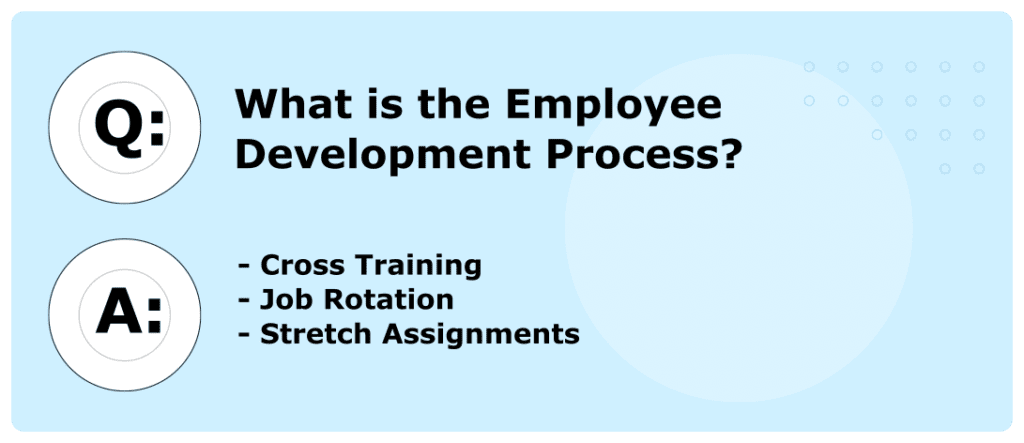
Employees perform better when they have the confidence and support of their employer behind them. Isn’t it funny that sometimes it takes the perspective of an outsourced HR provider to make it possible? Not only does the employee development process improve the credentials, skill sets, and knowledge-base of your employees, but it also represents your commitment to their personal growth and helps foster trust between you and your employees. That’s a big win. Plus, your employees become experts at their roles in the organization.
The more resources you put towards employee development, the more impact you’ll see within your organization. You improve retention, attract better talent, see internal processes improve, and you witness more innovation as you encourage decision making, creativity, and independent processes.
What is Meant By Employee Development?
Employee development is a cooperative, reciprocal process. It’s aimed at helping employees grow their skills and knowledge in their field to be more successful at their roles in the organization. But the purpose of employee development and training is to align and fulfill the objectives of both the employee and the business.
There are four main approaches to employee development:
Formal Education – Is more education and formalized training necessary to achieve employee and employer objectives?
Assessment – Do employees know where they stand in terms of fulfilling current responsibilities and meeting expectations, their strengths and weaknesses, and their path forward?
Job Experiences – Are employees put in situations where they are encouraged to take chances, work independently, or take more time on projects?
Interpersonal Relationships – How much do employees interact with a focus on personal development, training, and mentorship/coaching?
What is the Employee Development Process?

Every organization approaches employee development differently—some place more value on formal education, for example—but here we’ll focus on job experiences and interpersonal relationships, two approaches to employee development you can work towards each day.
Many employee development tools occur naturally within the workplace. When faced with the question of how to train and develop employees, use this list to identify what activities are already occurring that you can expound upon and grow.
Job Experiences
- Cross-training – When employees from different departments interact, they are sharing information about what they do, their processes, the technology and systems used, and how their role fits into the bigger picture. Involve more departments in projects where they interact. Include cross-training activities in their employee development plan.
- Job Rotation – What happens when you listen if an employee expresses interest in a different department, position, or role? Job rotation can be as dynamic as you want, you just need to clearly define which positions are eligible for job rotation and define boundaries.
- Stretch Assignments – Stretch assignments are projects on the job that encourage employees to step out of their comfort zone. These are real-life situations where employees can take chances in a professional environment.
Interpersonal Relationships
- Mentorship & Coaching – While mentorship and coaching often occur naturally within the hierarchical organization of your business, we often don’t formalize and encourage mentorship and coaching in the workplace as often as we should.
- Job Shadowing – You might already conduct job shadows during your onboarding process. There’s no reason not to continue to use this tool to train employees and allow them to observe other employees on a day-to-day basis. This works in tandem with cross-training and mentorship strategies, giving employees a chance to learn from others.
How Do You Develop an Employee Development Plan?
An employee development plan helps formalize the goals and approaches between you and the employee. These agreements can be standardized, and often an employee development plan template is helpful in outlining what you each aim to achieve, the steps that you’ll take, and the assessment used to determine if the process has been successful. You might even document what success means, like improved employee performance or meeting certain metrics.
Get Objective Perspective on Employee Development
Navigating an employee development plan with the individual should be cooperative. In fact, that’s where an HR outsourcing provider can be especially helpful, acting as a third party mediator to help guide the employee development process.
At Milestone, we understand the need for creating positive, reciprocal employee development processes with your current and future employees. Often, an expert outside perspective is exactly what you need to kickstart development and training shifts within your organization.
We outline exactly what to expect when creating employee development plans, including all the potential tools and processes at your disposal to apply towards employee growth and ongoing training. If you want to learn more, contact us today and start a conversation that could lead to impactful employee development strategies that benefit your business and your employees.
Related Content

Startup Employee Benefits – Compensation and Health Benefits for Startup Companies
At its core, your startup or small business should include the following benefits: Health Insurance (vision and dental), paid time ...

How To Pay Employees in a Startup
At a fundamental level, HR management includes any tasks that help optimize your most valuable resource—your people!

What Are the 4 Fundamentals of HR?
At a fundamental level, HR management includes any tasks that help optimize your most valuable resource—your people!
Stay in the know